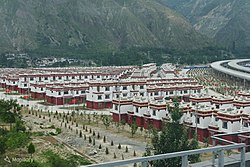
Back Wudu Qu CEB Wudu (Longnan) German Wudu barrutia Basque بخش وودو Persian District de Wudu French Distretto di Wudu Italian 武都区 Japanese 우두구 Korean Wudu MWL Wudu (Longnan) NB
Wudu
武都区 | |
|---|---|
 Tibetan-style homes in Pingya, Wudu | |
 Wudu in Longnan | |
 Longnan in Gansu | |
| Coordinates: 33°22′13″N 104°57′37″E / 33.3702°N 104.9604°E | |
| Country | China |
| Province | Gansu |
| Prefecture-level city | Longnan |
| District seat | Zhonglou Subdistrict |
| Area | |
| • Total | 4,683 km2 (1,808 sq mi) |
| Population (2020 census)[1] | |
| • Total | 546,616 |
| • Density | 120/km2 (300/sq mi) |
| Time zone | UTC+8 (China Standard) |
| Postal code | 746000 |
| Website | www |
| Wudu, Longnan | |||||||||||
|---|---|---|---|---|---|---|---|---|---|---|---|
| Chinese name | |||||||||||
| Simplified Chinese | 武都区 | ||||||||||
| Traditional Chinese | 武都區 | ||||||||||
| |||||||||||
| Tibetan name | |||||||||||
| Tibetan | བོད་ཏོག་ཆུས། | ||||||||||
| |||||||||||
Wudu District (Chinese: 武都区) is a district and the political and cultural centre of Longnan, Gansu province, China.[2] It borders the provinces of Shaanxi and Sichuan to the southeast. It has a population of 590,000, of which 110,000 live in the urban area.[3]
Located along the Bailong River near the borders with Sichuan and Shaanxi, it has been the site of many historic battles. A town has existed at the current county seat since at least 448. In 572 this town was named Wuzhou (武州), in 892 it was named Jiezhou. Since 1260 it was part of Shaanxi province, becoming part of Gansu in 1729. In 1913, Wudu County was established. The current district was established from Wudu County in 2004.[4]
The epicentre of the 1879 Gansu earthquake was located in the district.
Wudu is one of the top tourist destinations in Gansu, receiving over 2 million tourists in 2016.[5] The Wanxiang karst cave is located 10 km from the city.[6] Its agricultural output includes olive cultivation, traditional Chinese medicine crops and Sichuan pepper.[7][8][9][10]
- ^ "陇南市第七次全国人口普查公报" (in Chinese). Government of Longnan. 2021-05-25.
- ^ 毛树林; 赵殷; 三道 (2010-09-01). 大爱:深圳援建陇南纪实 (in Chinese). Beijing Book Co. Inc. ISBN 978-7-999022-56-5.
- ^ "武都区人民政府—魅力武都". www.gslnwd.gov.cn. Retrieved 2021-01-23.
- ^ "历史沿革". www.gslnwd.gov.cn. Retrieved 2021-01-23.
- ^ "甘肃省陇南市武都区-新华网". www.xinhuanet.com. Archived from the original on January 30, 2021. Retrieved 2021-01-23.
- ^ "甘肃武都万象洞:神秘罕见的西北喀斯特溶洞". www.sohu.com. Retrieved 2021-01-23.
- ^ "马营镇:中药材成为脱贫路上的新"方剂"". www.gslnwd.gov.cn. Retrieved 2021-01-23.
- ^ "武都:花椒产业助推脱贫攻坚". www.gslnwd.gov.cn. Retrieved 2021-01-23.
- ^ "武都油橄榄产业实现经济生态效益双丰收". www.gslnwd.gov.cn. Retrieved 2021-01-23.
- ^ 王义 (2013-05-01). 甘肃省城乡一体化试点成就纪实 (in Chinese). Beijing Book Co. Inc. ISBN 978-7-226-04441-4.
© MMXXIII Rich X Search. We shall prevail. All rights reserved. Rich X Search
